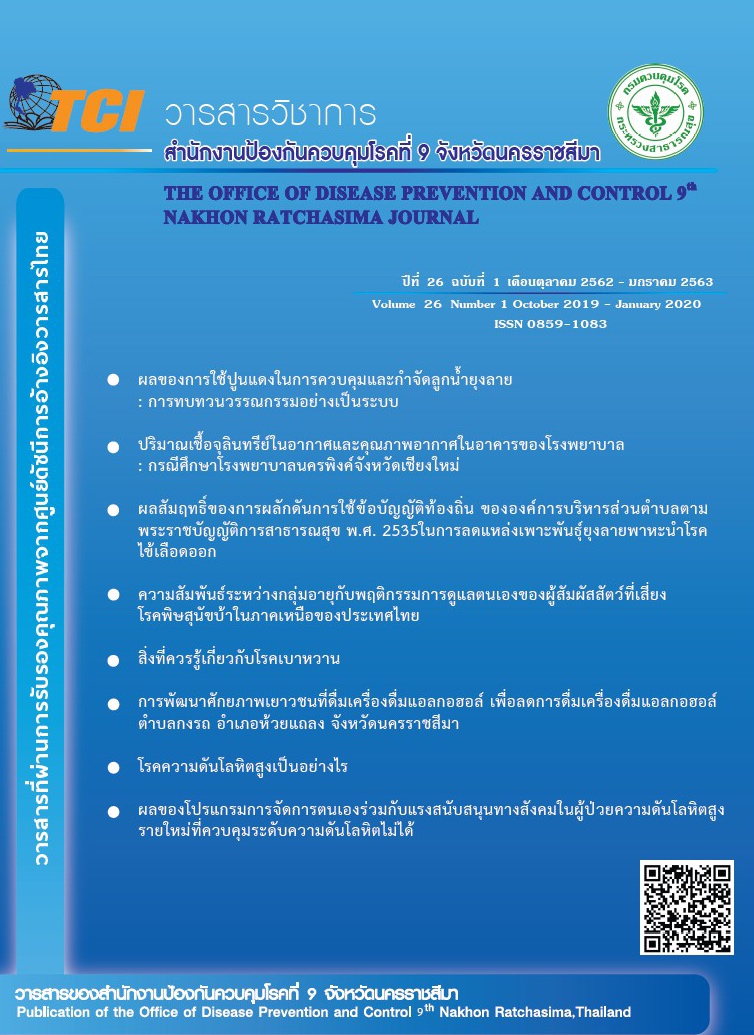สิ่งที่ควรรู้เกี่ยวกับโรคเบาหวาน
คำสำคัญ:
โรคเบาหวานบทคัดย่อ
เบาหวานเป็นกลุ่มโรคเมตาบอลิซึมที่พบบ่อย โดยลักษณะที่พบเป็นภาวะนํ้าตาลในเลือดสูง เบาหวานมี
ความแตกต่างกันหลายชนิดโดยเกิดจากปฏิสัมพันธท์ ี่ซับซอ้ นของกรรมพันธุแ์ ละปจั จัยทางสิ่งแวดลอ้ ม ขึ้นอยูกั่บ
สาเหตุของเบาหวาน ปัจจัยที่สนับสนุนให้นํ้าตาลในเลือดสูงเกิดจากการหลั่งอินซูลินจากร่างกายโดยตับอ่อนลดลง
การลดการใช้นํ้าตาลและการนำเข้านํ้าตาลเพิ่มขึ้น เมตาบอลิซึมจะอธิบายอย่างละเอียดถึงสรีรวิทยาของหลาย
อวัยวะที่เปลี่ยนไปซึ่งเปน็ สาเหตุของเบาหวานทำใหเ้ ปน็ ภาระอันใหญห่ ลวงของผูป้ ว่ ยเบาหวานแตล่ ะคนและระบบ
บริการ เบาหวานทำให้นำไปสู่ภาวะไตวายระยะสุดท้าย การถูกตัดขาและตาบอดในสหรัฐอเมริกา เบาหวานจูงใจ
ให้เกิดโรคหลอดเลือดหัวใจ เบาหวานเป็นสาเหตุการตายและพิการมีอุบัติการณ์เพิ่มขึ้นทั่วโลก โรคเบาหวานคือ
โรคที่เซลล์ร่างกายมีความผิดปกติในขบวนการเปลี่ยนนํ้าตาลในเลือดให้เป็นพลังงาน เมื่อนํ้าตาลไม่ได้ถูกใช้จึง
ทำให้ระดับนํ้าตาลในเลือดสูงกว่าระดับผิดปกติ ในปัจจุบันใช้เกณฑ์นํ้าตาลที่ >126 มก/ดล โดยมีข้อแม้ว่าเป็นค่า
ของนํ้าตาลในเลือดหลังจากอดอาหารอย่างน้อย 8 ชั่วโมง ถ้าบังเอิญรับประทานอาหารแต่ต้องการตรวจเลยโดย
ไม่อยากกลับมาใหม่ในวันรุ่งขึ้น จะดูค่า HbA1C ซึ่งเป็นเกณฑ์มาตรฐานที่ใหม่กว่า แม่นยำและนิยมใช้เพื่อจะบ่ง
บอกว่า ใครเป็นเบาหวานหรือไม่ โดยไม่จำเป็นต้องอดอาหารเช้าโดยใช้เกณฑ์ระดับนํ้าตาลในเลือด 200 mg/dl
เราใช้นํ้าตาลที่กินจากอาหารเพื่อให้เกิดพลังงาน นํ้าตาลที่กล่าวถึงคือกลูโคส ไม่ว่าจะรับประทานแป้ง เนื้อสัตว์
ไขมัน ผลไม้หรือผัก ในที่สุดจะต้องถูกย่อยให้เป็นหน่วยที่เล็กที่สุดคือนํ้าตาลกลูโคสก่อนเสมอแล้วกลูโคสจะเข้า
สู่ขบวนการที่เรียกว่า glucolysis เป็นการนำกลูโคสเข้าเซลล์จากนั้นจะได้พลังงาน ATP ออกมา ขั้นตอนนี้ต้องใช้
อินซูลิน หากขาดหรืออินซูลินลดลงก็จะเกิดโรคขึ้น
เอกสารอ้างอิง
ระวังป่วยโรคเบาหวานเผยไทยพบผู้ป่วยเบาหวานเกือบ 5 ล้านราย สำนักโรคไม่ติดต่อ / สำนักสื่อสาร
ความเสี่ยง ฯ กรมควบคุมโรค [เข้าถึงเมื่อ วันที่ 3 ธันวาคม 2561 เข้าถึงได้ https://ddc.moph.go.th/th/
site/office_newsview/view/1978.
2. ธนพร รัตนสุวรรณ. เข้าใจเบาหวาน. สมาคมโรคเบาหวานแห่งประเทศไทยในพระราชูปถัมภ์
สมเด็จพระเทพรัตนราชสุดาฯ สยามบรมราชกุมารีเข้าถึงได้จาก: /http://www.dmthai.org.
3. Longo Fauci Kasper Hauser Jameson Loscalizo, Harrison ‘s principles of internal medicine eighteenth edition
.Diabetes mellitus charter 344 p 2968—3003.
4. N. Sattar. Revisiting the links between glycaemia, diabetes and cardiovascular disease.
Springer-Verlag Berlin. Diabetogia April 2013, volume 56:p686-695 เข้าถึงได้จาก:
/http://link.springer.com.
5. Plengvidhya, et al. j Med. Thailand diabetes registry project : prevalence and risk factors of stroke .Pubmed 2006
เข้าถึงได้จาก: /http://www.ncbi.nlm.nih.gov.

ดาวน์โหลด
เผยแพร่แล้ว
รูปแบบการอ้างอิง
ฉบับ
ประเภทบทความ
สัญญาอนุญาต
บทความที่ลงพิมพ์ในวารสารวิชาการสำนักงานป้องกันควบคุมโรคที่ 9 จังหวัดนครราชสีมา ถือว่าเป็น
ลิขสิทธิ์ สำนักงานป้องกันควบคุมโรคที่ 9 จังหวัดนครราชสีมา



